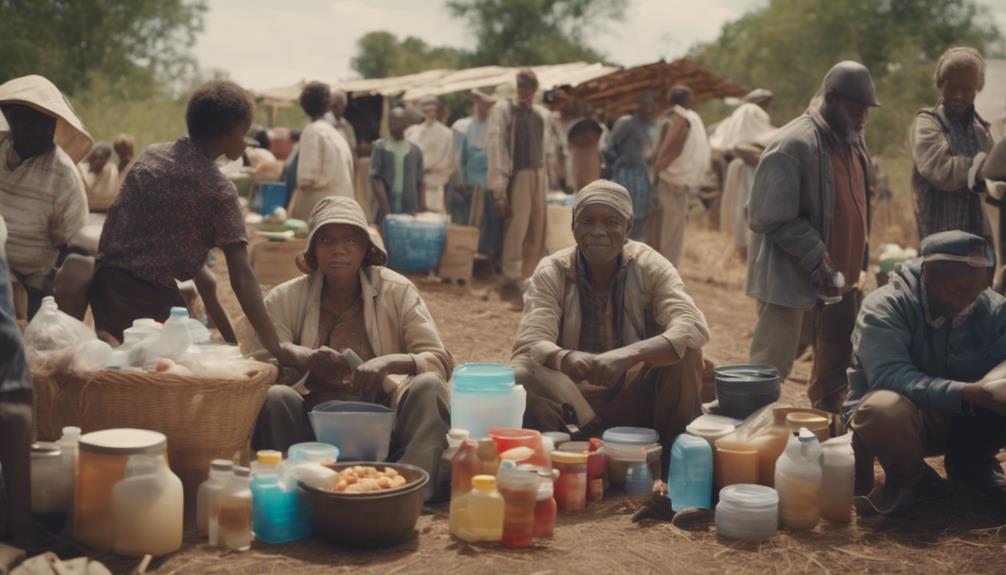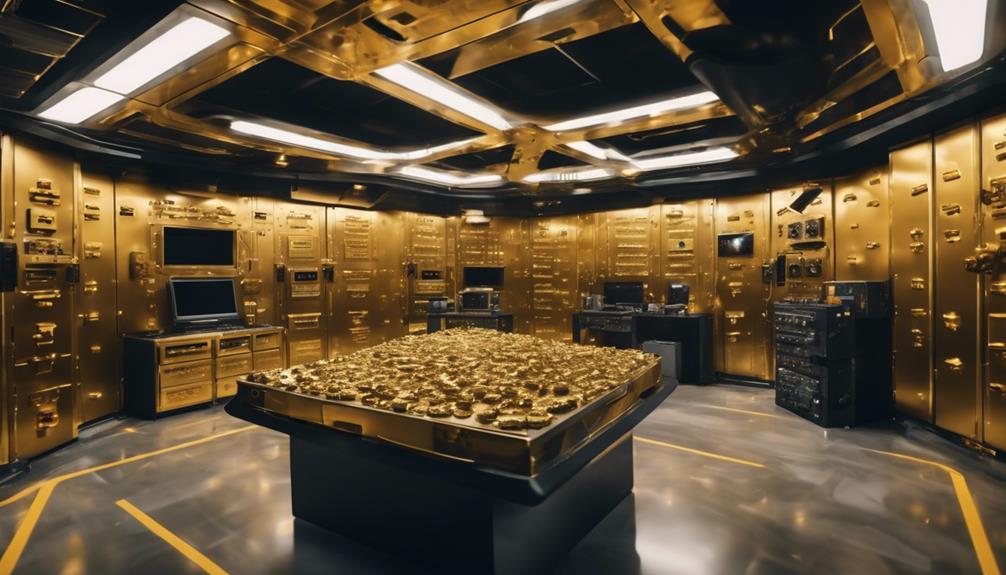Preppers are individuals who prepare for disasters, while survivalists focus on extreme scenarios. They stockpile essentials, invest in tools, and learn survival skills. Originating during the Cold War, prepping expanded to cover various threats. Preppers prioritize self-reliance, fortify homes, and emphasize personal responsibility. Around 4 to 9 million active preppers exist in the U.S., with growing interest globally. Misconceptions label them as extremists, but prepping is a practical approach for safety. As Gen Z individuals show interest, the future of prepping looks promising. Understanding the movement, its diversity, and the value of being prepared is essential for all.
Key Takeaways
- Preppers prepare for disasters, survivalists focus on extreme scenarios.
- Preppers emphasize readiness, self-reliance, and traditional survival skills.
- Stockpile food, water, first aid, and self-defense tools.
- Preppers fortify homes, build bunkers, or live off-grid for safety.
- Prepping demographics diverse, with motivations ranging from personal safety to distrust in government crisis management.
Preppers Vs. Survivalists
When distinguishing between preppers and survivalists, it's important to recognize their differing focuses and approaches to preparedness. Preppers tend to prepare for a wide array of potential disasters, ranging from natural calamities to economic crises, focusing on practical measures like stockpiling food and water.
On the other hand, survivalists often concentrate on apocalyptic scenarios, envisioning extreme and long-term survival situations that may require more combative skills.
The survivalist movement has historical roots dating back to the post-World War II era, emphasizing self-reliance and readiness for societal collapse. In contrast, prepping has evolved to encompass a broader spectrum of threats in response to modern challenges.
While preppers engage in proactive preparedness measures, survivalists are typically associated with a more aggressive and combative approach to survival. Both groups focus on self-reliance, but their methods and mindsets can differ significantly. Some preppers may integrate **Christian survival strategies**, emphasizing faith-based resilience alongside material readiness. In contrast, survivalists might prioritize tactical skills and readiness for hostile scenarios, often adopting a more militaristic outlook on preparing for potential threats.
As the survivalist movement has become distinct from prepping, it highlights the varying philosophies within the realm of emergency preparedness, with survivalists preparing for extreme scenarios and preppers adopting a more thorough approach to readiness.
Origins of Prepping

Prepping, originating in the 1950s during the Cold War era, was driven by nuclear threats and mass paranoia. The fear of potential nuclear attacks led individuals to seek ways to protect themselves and their families.
Survival retreats, often located in remote areas, became popular among those preparing for worst-case scenarios. The US government's initiatives promoting fallout shelters and civil defense programs further fueled the development of prepping practices.
Over time, prepping expanded beyond survival retreats, encompassing a broader focus on self-reliance and disaster preparedness. The term 'prepper' emerged in 2001, marking a shift towards mainstream acceptance of prepping ideologies and methods.
Events such as 9/11 and Hurricane Katrina increased interest in preparedness measures among Americans, demonstrating the relevance and importance of being ready for unforeseen emergencies.
Common Preparations

Common preparations made by preppers include stockpiling supplies like food, water, and essential items to guarantee they can sustain themselves during emergencies. This proactive approach aims to mitigate risks and enhance self-sufficiency in times of crisis.
Many preppers also invest in first aid kits, self-defense tools, and communication devices to bolster their preparedness levels. Bug out bags are another prevalent strategy among preppers, containing crucial items for a quick evacuation if needed.
Furthermore, preppers often acquire wilderness survival skills such as foraging, shelter-building, and fire-making to increase their ability to thrive in natural environments. Some individuals within this community take it a step further by fortifying their homes, constructing bunkers, or establishing off-grid living spaces to ensure their safety and survival across various scenarios.
This dedication to preparedness showcases the diverse strategies preppers employ to safeguard themselves and their loved ones in uncertain circumstances.
Prepper Demographics

To grasp the breadth of the survivalist movement, it's enlightening to examine the demographics of preppers and their characteristics. In the U.S., preppers are estimated to range from 4 to 9 million active individuals. Remarkably, Gen Z individuals stand out as the most likely age group to engage in prepping, showing a growing interest in self-reliance and preparedness.
FEMA reported a significant 50% increase in self-reliant individuals in the U.S. from 2017 to 2020, indicating a trend towards proactive emergency readiness.
Beyond the U.S., European preppers express significant distrust in their governments' crisis management capabilities, further fueling the prepping movement. This mindset has also permeated globally, with prepping evolving into a phenomenon driven by climate breakdown and geopolitical tensions.
The demographic landscape of preppers is diverse, reflecting a broad spectrum of individuals who prioritize readiness and self-sufficiency in an uncertain world.
Personal Philosophy

Embracing a mindset of self-reliance and preparedness, preppers prioritize autonomy in managing uncertain circumstances. They believe in the importance of self-sufficiency, considering it a citizen's duty to care for themselves and their families during emergencies.
Many preppers idealize the independence of past generations and advocate for acquiring traditional survival skills. This philosophy places a strong emphasis on readiness for a range of disaster scenarios, whether natural calamities or societal breakdowns.
Aligning with traditional American values of independence and resilience, preppers view self-reliance as a cornerstone of their personal philosophy. By valuing self-sufficiency and traditional survival skills, preppers aim to be well-equipped to navigate challenging situations without having to rely heavily on external aid.
This philosophy reflects a desire to be proactive in mitigating risks and being prepared for potential disruptions, grounding their actions in a belief in personal responsibility and autonomy.
Media Portrayal

Media outlets often depict preppers as individuals stockpiling weapons and preparing for doomsday scenarios. TV shows like 'Doomsday Preppers' have played a significant role in shaping public perception, portraying preppers as eccentric and paranoid individuals.
While some coverage focuses on the extreme aspects of prepping, there are also instances where the practical elements, such as emergency preparedness and self-sufficiency skills, are highlighted. Documentaries like 'American Blackout' offer insight into the challenges preppers face and the strategies they employ in simulated disaster scenarios.
With the rise of online platforms and social media, preppers now have a space to share their experiences and knowledge, influencing how they're portrayed in the media. This digital presence has allowed for a more nuanced understanding of prepping beyond the traditional sensationalized portrayals seen in mainstream media.
Pop Culture Influence

Pop culture plays a significant role in shaping society's perception of survivalist ideals. The prevalence of apocalyptic and dystopian content in movies, TV shows, and books has fueled an interest in prepping and self-reliance.
These portrayals often influence cultural stereotypes associated with the survivalist movement.
Media Portrayal
Portrayed in various forms of entertainment, the survivalist movement has captured widespread attention through its depiction in popular culture. TV shows like 'Doomsday Preppers' and post-apocalyptic series such as 'The Walking Dead' have brought prepping and survivalism into the mainstream.
However, the media often sensationalizes these practices, leading to misconceptions and stereotypes about survivalists. Movies like 'The Book of Eli' and video games like 'Fallout' contribute to the portrayal of preppers as extreme doomsday believers. Social media influencers on platforms like YouTube and Instagram also play a role in sharing preparedness tips with a broad audience.
These portrayals sometimes create the misconception that all survivalists are paranoid or preparing for an imminent catastrophic event. In reality, many preppers are simply focused on being self-sufficient and prepared for emergencies. It's important to distinguish between the exaggerated media portrayals and the diverse motivations behind why individuals choose to embrace prepping and survivalism.
Cultural Stereotypes
Stereotyping preppers as extremists or conspiracy theorists is a common narrative perpetuated by popular culture. TV shows like 'Doomsday Preppers' have sensationalized prepping, leading to misconceptions about the movement. Movies and books often depict preppers as isolated, paranoid individuals, further fueling cultural stereotypes. These negative stereotypes overlook the diverse reasons people engage in prepping, from natural disaster preparedness to self-sufficiency. Despite these misconceptions, prepping is a practical and proactive approach to ensuring personal and family safety in times of crisis.
It's important to recognize that these stereotypes aren't reflective of the entire prepper community. Preppers come from various backgrounds and have different motivations for preparing for emergencies. By understanding the true reasons behind prepping, one can appreciate the value of being prepared for unforeseen circumstances.
Instead of focusing on the negative stereotypes perpetuated by popular culture, it's crucial to approach prepping with an open mind and a willingness to learn about the practical aspects of this survivalist movement.
Future of Prepping

Moreover, the future of prepping appears to hold significant promise and growth potential, driven by evolving global trends and demographics. Gen Z individuals are increasingly engaging in prepping activities, marking a shift towards a younger audience interested in preparedness. Additionally, the commercialization of prepping is evident as companies capitalize on the expanding market and affluent individuals invest in self-sufficient retreats.
Global trends influencing the future of prepping include climate breakdown, geopolitical tensions, and a rising skepticism towards government crisis management capabilities. These factors contribute to the growing interest in prepping practices worldwide. The survival tools market is projected to reach $2.46 billion by 2030, indicating the significant interest and investment in prepping tools and resources.
As the world becomes more unpredictable, the appeal of prepping continues to rise, with a diverse range of individuals embracing the importance of readiness for potential emergencies.
Frequently Asked Questions
What Is the Difference Between a Prepper and a Survivalist?
In prepping, you focus on readiness for various disasters, while survivalists prep for apocalyptic events and societal collapse. Preppers stockpile supplies, develop skills, and build communities. Survivalists may train paramilitarily, create alternative economies, and plan for extended survival.
What's the Point of Preppers?
The point of prepping is to be ready for anything life throws your way. By stocking up on supplies and learning essential skills, you can guarantee your self-sufficiency during emergencies and disasters.
What Are the Traditions of Preppers?
Discussing the traditions of preppers involves understanding their focus on self-sufficiency, stockpiling supplies, acquiring survival skills, and creating evacuation plans. Preppers emphasize preparedness, planning, and resilience in the face of potential emergencies.
What Do Survivalists Believe?
In a world teetering on the edge, survivalists see cracks in the foundation. They believe in self-reliance, preparing for chaos with stockpiles and skills. Bug out or bug in, it's all about being ready.
Conclusion
In summary, preppers are individuals who prioritize readiness for potential disasters and emergencies. With a focus on self-sufficiency and preparedness, they stockpile supplies, develop survival skills, and plan for various scenarios.
While often misunderstood, preppers play a vital role in promoting resilience and security in uncertain times. So, next time you see a prepper, remember they aren't just preparing for the worst, but also embodying the age-old saying, 'better safe than sorry.'










